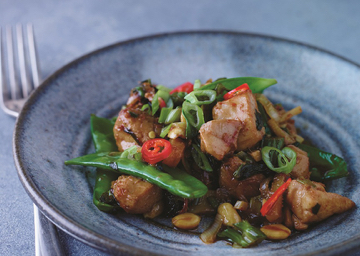- 1 1/2 pounds boneless, skinless chicken thighs, cut into 1-inch pieces
- 1 tablespoon sambal oelek (Asian chile sauce)
- 1 tablespoon cornstarch
- 1 tablespoon rice wine or sake (or rice vinegar)
- ¼ cup soy sauce, divided
- ¼ cup vegetable or peanut oil
- One 2-inch piece of ginger, peeled and cut into thin matchsticks
- 2 garlic cloves, minced
- 2 scallions, thinly sliced, white and green parts kept separate
- 2 small celery stalks, thinly sliced, plus 1⁄2 cup roughly chopped celery leaves
- 2 large shallots, halved lengthwise and thinly sliced
- 2 teaspoons sugar
- ¼ cup unsalted dry-roasted peanuts
- ½ lb. snow peas, ends trimmed
- ¼ cup drained and sliced water chestnuts
- Kosher salt
- 1 hot red chile, thinly sliced (optional)
Until recently, whenever I made stir-fried chicken with vegetables, I was disappointed. It was really bland, as if all I was doing was sautéing except on a higher heat, with a splash of soy sauce at the end. Then everything changed when Bizarre Foods host Andrew Zimmern shared his recipe and technique. It involved more work, but the result was infinitely more nuanced and delicious. First he showed me how to flip ingredients in a pan without a spatula, using peanuts until I got the hang of it. He taught me to thrust the pan quickly forward and then pull back, which is incredibly awkward at first. After a few practice rounds, I got to use raw chicken chunks, which I tossed in the air and then saw land on the floor. I did learn something important as I picked up the pieces. Andrew asked me what it felt like. “It’s slippery,” I said. “Exactly. That’s the feel of velveted chicken. It gets that way from the cornstarch.” The next time, the chicken stayed in the pan and I tossed in snow peas and water chestnuts. As the stir-fry cooked, the drippings got crusty and brown—what I would have called a fail, until Andrew instructed me to pour in a bit of water. All of a sudden, the browned bits released from the pan and made the most astonishing sauce. And when I mixed in the fragrant sautéed ginger, shallot, scallion, garlic, celery, peanuts and sugar, I knew I had a new favorite weeknight dish.
ingredients
directions
1. Put the chicken in a large bowl. Add the sambal oelek, cornstarch, rice wine and 2 tablespoons of the soy sauce and toss to coat. Set aside. |
2. Set a large heavy skillet over very high heat and add 2 tablespoons of the oil. When the oil ripples (Andrew refers to this as “when it smiles”), add the ginger, garlic and scallion greens and cook over high heat, stirring, until fragrant, about 30 seconds. Add the celery, celery leaves, shallots, sugar and peanuts and cook, stirring, until the vegetables are crisp-tender, about 2 minutes. Transfer the mixture to a plate and set aside. |
3. Add the remaining 2 tablespoons of oil to the skillet and let it get quite hot over medium-high heat. Add the chicken in a single layer and let it sit for a moment before stirring, then cook, stirring, until well browned and nearly cooked through, about 5 minutes. Add the snow peas and water chestnuts and cook, stirring, until the snow peas are bright green and crisp-tender, about 3 minutes. |
4. Add the reserved ginger and celery mixture, along with the final 2 tablespoons of soy sauce and a couple tablespoons of water, and scrape up the flavorful bits stuck to the bottom of the pan with a wooden spoon. Then stir everything together and season to taste with salt. |
5. Transfer the chicken to a platter and scatter the scallion whites and chile, if using, on top. Serve immediately. |
Notes
 Chef Tips From Andrew Zimmern Chef Tips From Andrew ZimmernON CUTTING CHICKEN Cut boneless chicken thighs into 3 sections. Then cut each third into an even dice. ON CORNSTARCH Don’t be afraid to use cornstarch. It helps tighten the sauce and gives the chicken a twice cooked slippery quality that people associate with good Chinese wok cookery. It makes the meat soft and tender. ON THE SMARTEST ADDITION TO A STIR-FRY Celery has a very strong flavor (think about its effect in chicken stock) that makes it a staple of Chinese cooking. ON PREPPING GINGER Use a spoon to scrape off the skin. Then cut a thin slice off one side so it sits flat on the cutting board and you’re not fighting a ball as you slice it. ON SOY SAUCE Be sure to taste your soy sauce before using it. Soy sauce that’s been sitting in your cupboard or refrigerator will be stronger because some of the liquid will have evaporated. ON SCALLIONS Use scallions in cooking and for finishing a dish too. The green parts have a tart acidity—a nice balance to the sweetness of the cooked whites. ON FLIPPING INGREDIENTS IN A PAN To learn to flip ingredients as you sauté, practice with peanuts or dried beans (something easy to pick up and cheap!). You’re just pushing them up and then catching them. Push and catch, push and catch. But don’t throw them up too high. CHEF VARIATION To “velvet” the chicken, soak it overnight in a mixture of cornstarch, rice wine and chiles and then stir-fry it. |
Categories
Chinese


